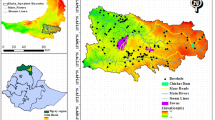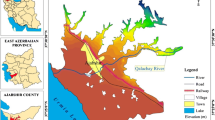Abstract
One of the major causes of groundwater pollution in Hamadan–Bahar aquifer in western Iran is a non-point source pollution resulting from agricultural activities. Withdrawal of over 88% of drinking water from groundwater resources, adds urgency to the studies leading to a better management of water supplies in this region. In this study, the DRASTIC model was used to construct groundwater vulnerability maps based on the “intrinsic” (natural conditions) and “specific” (including management) concepts. As DRASTIC has drawbacks to simulate specific contaminants, we conditioned the rates on measured nitrate data and optimized the weights of the specific model to obtain a nitrate vulnerability map for the region. The performance of the conditioned DRASTIC model improved significantly (R 2 = 0.52) over the intrinsic (R 2 = 0.12) and specific (R 2 = 0.19) models in predicting the groundwater nitrate concentration. Our study suggests that a locally conditioned DRASTIC model is an effective tool for predicting the region’s vulnerability to nitrate pollution. In addition, comparison of groundwater tables between two periods 30 years apart indicated a drawdown of around 50 m in the central plain of the Hamadan–Bahar region. Our interpretation of the vulnerability maps for the two periods showed a polluted zone developing in the central valley requiring careful evaluation and monitoring.







Similar content being viewed by others
References
Abbaspour KC (2007) User manual for SWAT-CUP, SWAT calibration and uncertainty analysis programs. Swiss Federal Institute of Aquatic Science and Technology, Eawag, Dübendorf, Switzerland. http://www.eawag.ch/organisation/abteilungen/siam/software/swat/index_EN. Accessed Aug 2009
Abbaspour KC, Yang J, Maximov I, Siber R, Bogner K, Mieleitner J, Zobrist J, Srinivasan R (2007) Modelling hydrology and water quality in the pre alpine/alpine Thur watershed using SWAT. J Hydrol 333:413–430
Al-Adamat RAN, Foster IDL, Baban SMJ (2003) Groundwater vulnerability and risk mapping for the Basaltic aquifer of the Azraq basin of Jordan using GIS, remote sensing and DRASTIC. Appl Geogr 23:303–324
Aller L, Bennett T, Lehr JH, Petty RJ, Hackett G (1987) DRASTIC: a standardized system for evaluating ground water pollution potential using hydrogeologic settings. EPA-600/2-87-035, EPA, Washington
Almasri MN (2008) Assessment of intrinsic vulnerability to contamination for Gaza coastal aquifer, Palestine. J Environ Manage 88(4):577–593
Arnold JG, Srinivasan R, Muttiah RS, Williams JR (1998) Large area hydrologic modeling and assessment—Part 1: model development. J Am Water Resour Assoc 34:73–89
Babiker IS, Mohamed AAM, Hiyama T, Kato K (2005) A GIS based DRASTIC model for assessing aquifer vulnerability in Kakamigahara Heights, Gifu Prefecture, Central Japan. Sci Total Environ 345(1–3):127–140
Chitsazan M, Akhtari Y (2008) A GIS-based DRASTIC model for assessing aquifer vulnerability in Kherran plain, Khuzestan, Iran. Water Resour Manage. doi:10.1007/s11269-008-9319-8
Garrett P, Williams JS, Rossoll CF, Tolman AL (1989) Are ground water vulnerability classification systems workable? In: Proceedings of FOCUS conference on eastern regional ground water issues, Kitchener, Ontario, Canada, National Water Well Association, Dublin, Ohio, 17–19 October, pp 329–343
Gogu RC, Dassargues A (2000) Current trends and future challenges in groundwater vulnerability assessment using overlay and index methods. Environ Geol Environ Geol 39(6):549–559
Hamza MH, Added A, Rodriguez R, Abdeljaoueda S, Ben Mammou A (2007) A GIS-based DRASTIC vulnerability and net recharge reassessment in an aquifer of a semi-arid region (Metline-Ras Jebel-Raf Raf aquifer, Northern Tunisia). J Environ Manage 84:12–19
Jalali M (2005) Nitrates leaching from agricultural land in Hamadan, western Iran. Agric Ecosyst Environ 110:210–218
Kalinski RJ, Kelly WE, Bogardi I, Ehrman RL, Yamamoto PO (1994) Correlation between DRASTIC vulnerabilities and incidents of VOC contamination of municipal wells in Nebraska. Ground Water 32(1):31–34
McKay MD, Beckman RJ, Conover WJ (1979) A comparison of three methods for selecting values of input variables in the analysis of output from a computer code. Technometrics 21:239–245
McLay CDA, Dragden R, Sparling G, Selvarajah N (2001) Predicting groundwater nitrate concentrations in a region of mixed agricultural land use: a comparison of three approaches. Environ Pollut 115:191–204
Merchant J (1994) GIS-based groundwater pollution hazard assessment: a critical review of the DRASTIC model. Photogramm Eng Remote Sens 60(9):1117–1127
Mohammadi K, Niknam R, Majd VJ (2008) Aquifer vulnerability assessment using GIS and fuzzy system: a case study in Tehran–Karaj aquifer, Iran. Environ Geol. doi:10.1007/s00254-008-1514-7
Moradi A, Abbaspour KC, Afyuni M (2005) Modelling field-scale cadmium transport below the root zone of a sewage sludge amended soil in an arid region in Central Iran. J Contam Hydrol 79(3–4):187–206
Nadafian H (2007) Simulation of groundwater pollution around drinking water wells in Hamadan city. M.Sc. dissertation, Shahid Beheshti University, Tehran, Iran
Palmer RC, Lewis MA (1998) Assessment of groundwater vulnerability in England and Wales. In: Robins NS (ed) Groundwater pollution, aquifer recharge and vulnerability, special publications vol 130. Geological Society, London, pp 191–198
Panagopoulos GP, Antonakos AK, Lambrakis NJ (2006) Optimization of DRASTIC model for groundwater vulnerability assessment, by the use of simple statistical methods and GIS. Hydrogeol J 14:894–911
Piscopo G (2001) In: Groundwater vulnerability map, explanatory notes, Castlereagh Catchment, NSW. Department of Land and Water Conservation, Australia. http://www.dwe.nsw.gov.au/water/pdf/quality_groundwater_castlereagh_map_notes.pdf. Accessed Aug 2008
Rahman A (2008) A GIS-based DRASTIC model for assessing groundwater vulnerability in shallow aquifer in Aligarh, India. Appl Geogr 28:32–53
Rahmani A (2003) Study and investigation of pollution in groundwater of Hamadan-Bahar plain. Environmental Organization of Hamadan, Iran
Rosen L (1994) A study of the DRASTIC methodology with emphasis on Swedish conditions. Ground Water 32:278–285
Secunda S, Collin M, Melloul AJ (1998) Groundwater vulnerability assessment using a composite model combining DRASTIC with extensive land use in Israel’s Sharon region. J Environ Manage 54:39–57
Tyner JS, Wright WC, Yoder RE (2007) Identifying long-term preferential and matrix flow recharge at the field scale. T ASABE 50(6):2001–2006
Villeneuve JP, Banton O, Lafrance P (1990) A probabilistic approach for the groundwater vulnerability to contamination by pesticides: the VULPEST model. Ecol Model 51:47–58
Vrba J, Zaporozec A (1994) Guidebook on mapping groundwater vulnerability, vol 16. International Association of Hydrogeologists, Heise
Acknowledgments
The authors wish to acknowledge Hamadan Regional Water Authority, Water and Wastewater Co. of Hamadan, Isfahan University of Technology, and the Swiss Federal Institute for Aquatic science and Technology, Eawag, for providing assistance to conduct this study.
Author information
Authors and Affiliations
Corresponding author
Rights and permissions
About this article
Cite this article
Akhavan, S., Mousavi, SF., Abedi-Koupai, J. et al. Conditioning DRASTIC model to simulate nitrate pollution case study: Hamadan–Bahar plain. Environ Earth Sci 63, 1155–1167 (2011). https://doi.org/10.1007/s12665-010-0790-1
Received:
Accepted:
Published:
Issue Date:
DOI: https://doi.org/10.1007/s12665-010-0790-1




